Have you ever found yourself staring at your A.R.E tonneau cover, wondering what all those bits and pieces are called?
Well, you’re not alone! But don’t worry, I’ve got your back. In this article, I’m going to break down all the parts of an A.R.E tonneau cover for you.
Whether you’re looking to replace a part, do some maintenance, or just satisfy your curiosity, you’ve come to the right place.
So, grab a cup of coffee, get comfortable, and let’s dive into the world of A.R.E tonneau cover parts!
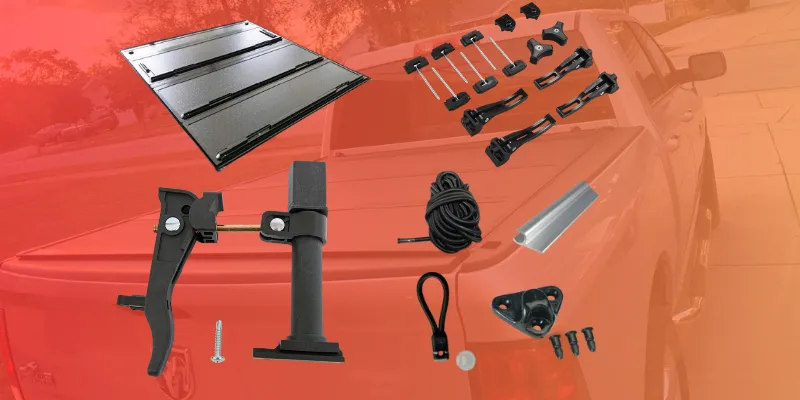
Understanding the Basics of A.R.E Tonneau Covers
A.R.E offers different types of tonneau covers, including:
- Hard folding covers
- Soft rolling covers
- One-piece lift-up covers
- Retractable covers
Each type has its own unique set of parts, but there are some common components across all models. Let’s explore these parts in detail.
The Frame: The Backbone of Your Tonneau Cover
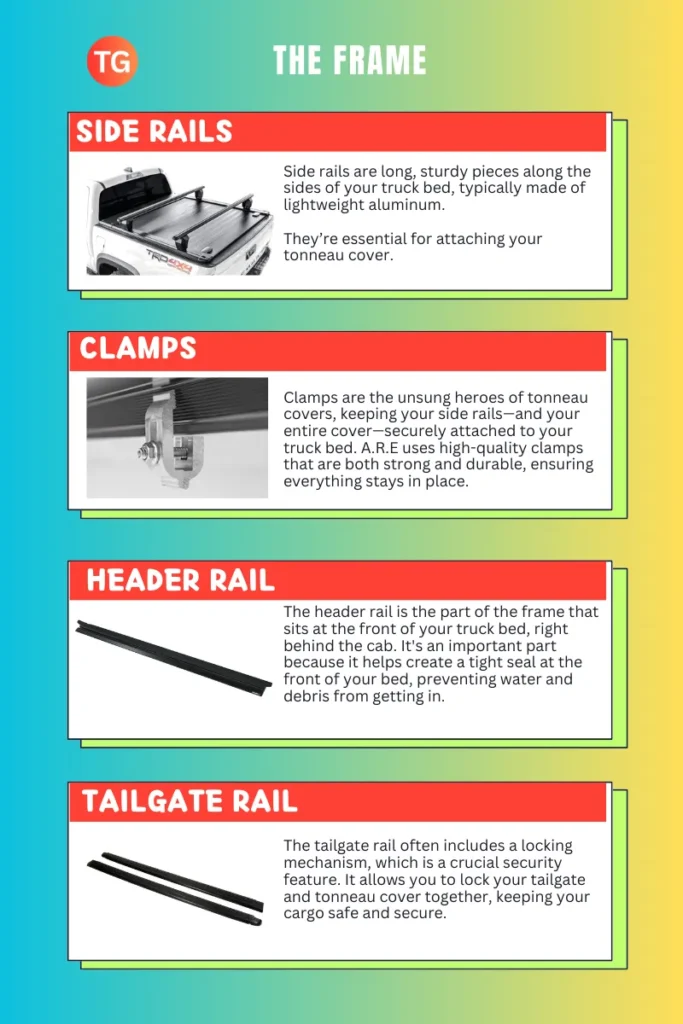
The frame is like the skeleton of your tonneau cover. It’s what gives the cover its structure and helps it fit snugly on your truck bed.
Here are the main parts of an A.R.E tonneau cover frame:
Side Rails
Side rails are long, sturdy pieces that run along the sides of your truck bed. They’re usually made of aluminum for a good balance of strength and light weight.
The side rails are what your tonneau cover attaches to, so they’re pretty important!
When you’re installing or maintaining your A.R.E tonneau cover, pay close attention to the side rails.
Make sure they’re properly aligned and securely fastened to your truck bed.
If they’re loose or misaligned, your cover might not seal properly, which could lead to leaks or other issues.
Clamps
Clamps are the unsung heroes of the tonneau cover world.
These little guys are responsible for keeping your side rails (and by extension, your whole tonneau cover) firmly attached to your truck bed.
A.R.E uses high-quality clamps that are designed to be strong and durable.
Most A.R.E tonneau covers use a no-drill clamping system.
This means you don’t have to drill holes in your truck to install the cover – a big plus if you ever want to remove the cover and restore your truck to its original condition.
Header Rail
The header rail is the part of the frame that sits at the front of your truck bed, right behind the cab.
It’s an important part because it helps create a tight seal at the front of your bed, preventing water and debris from getting in.
In some A.R.E models, the header rail might include a drain system to channel away any water that does manage to sneak in. Pretty neat, right?
Tailgate Rail
As you might guess, the tailgate rail is at the opposite end from the header rail. It sits right above your tailgate and helps secure the back end of your tonneau cover.
The tailgate rail often includes a locking mechanism, which is a crucial security feature.
It allows you to lock your tailgate and tonneau cover together, keeping your cargo safe and secure.
The Cover Material: What Keeps Your Cargo Dry
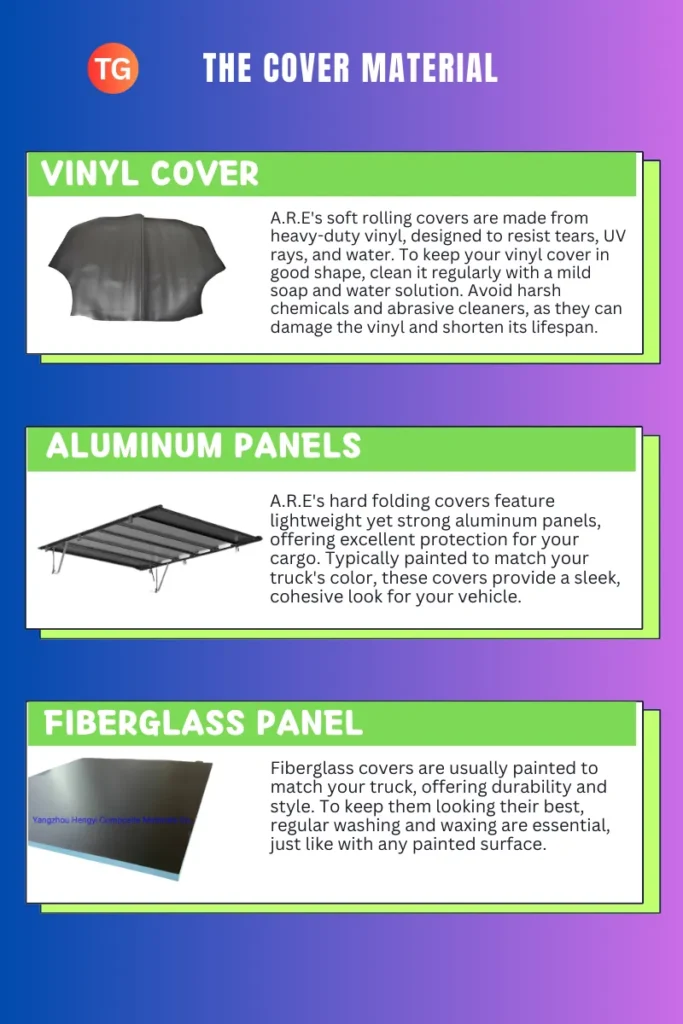
Now that we’ve covered the frame, let’s talk about the star of the show – the cover itself. A.R.E uses different materials for different types of covers:
Vinyl Cover
For soft rolling covers, A.R.E typically uses a heavy-duty vinyl material. This vinyl is tough stuff – it’s designed to resist tears, stand up to UV rays, and keep water out.
If you have a vinyl cover, you’ll want to clean it regularly with a mild soap and water solution.
Avoid using harsh chemicals or abrasive cleaners, as these can damage the vinyl and reduce its lifespan.
Aluminum Panels
Many of A.R.E’s hard folding covers use aluminum panels. These panels are lightweight but strong, providing excellent protection for your cargo.
They’re usually painted to match your truck’s color, giving your vehicle a sleek, cohesive look.
Aluminum panels are pretty low-maintenance, but you’ll want to keep them clean and check periodically for any signs of damage or wear.
Fiberglass Panel
For one-piece lift-up covers, A.R.E often uses fiberglass. Fiberglass is great because it’s strong, relatively lightweight, and can be molded into different shapes.
This allows A.R.E to create covers that perfectly match the contours of your truck.
Fiberglass covers are typically painted to match your truck. T
hey’re durable, but like any painted surface, they can benefit from regular washing and waxing to keep them looking their best.
Sealing and Weather Protection: Keeping the Elements Out
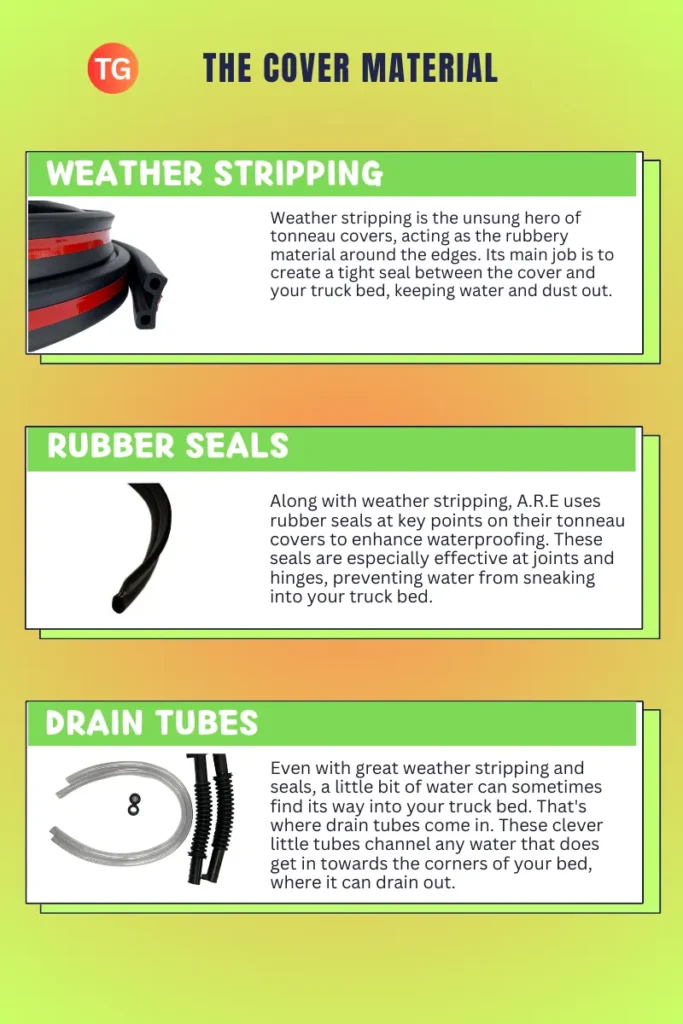
One of the main jobs of a tonneau cover is to keep your cargo dry and protected from the elements. A.R.E uses several components to achieve this:
Weather Stripping
Weather stripping is the unsung hero of tonneau covers. It’s that rubbery material you see around the edges of the cover.
Its job is to create a tight seal between the cover and your truck bed, keeping water and dust out.
Over time, weather stripping can wear out or become damaged.
If you notice any tears or if the stripping seems compressed and isn’t bouncing back, it might be time to replace it.
Rubber Seals
In addition to weather stripping, A.R.E uses rubber seals at various points on their tonneau covers.
These seals help to further waterproof your truck bed, especially at joints and hinges where water might try to sneak in.
Drain Tubes
Even with great weather stripping and seals, a little bit of water can sometimes find its way into your truck bed.
That’s where drain tubes come in. These clever little tubes channel any water that does get in towards the corners of your bed, where it can drain out.
If you notice water pooling in your truck bed, check your drain tubes. They might be clogged or disconnected.
Hardware: The Little Things That Matter
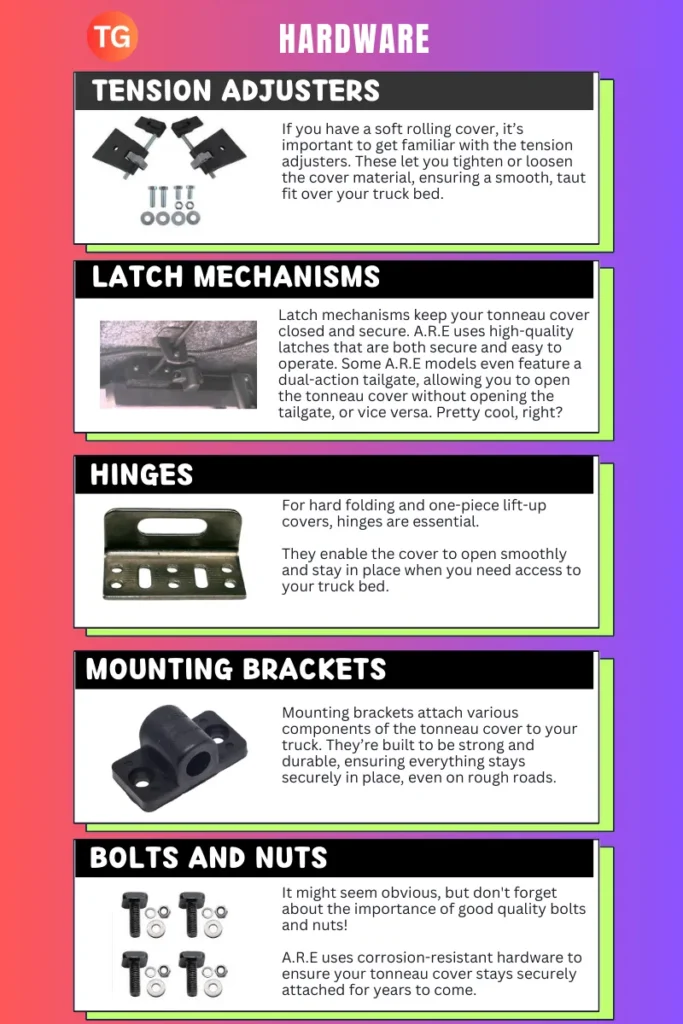
Now, let’s talk about the small but mighty parts that hold everything together:
Tension Adjusters
If you have a soft rolling cover, you’ll want to get familiar with the tension adjusters.
These allow you to tighten or loosen the cover material, ensuring a smooth, taut fit over your truck bed.
Latch Mechanisms
Latch mechanisms are what keep your tonneau cover closed and secure. A.R.E uses high-quality latches that are designed to be both secure and easy to use.
Some A.R.E models feature a dual-action tailgate, which means you can open the tonneau cover without opening the tailgate, or open the tailgate without opening the cover.
Pretty cool, right?
Hinges
For hard folding and one-piece lift-up covers, hinges are crucial components. They allow the cover to open smoothly and stay open when you need access to your truck bed.
A.R.E uses sturdy, weather-resistant hinges to ensure smooth operation in all conditions.
Mounting Brackets
Mounting brackets are used to attach various components of the tonneau cover to your truck.
They’re designed to be strong and durable, holding everything securely in place even when you’re driving on rough roads.
Bolts and Nuts
It might seem obvious, but don’t forget about the importance of good quality bolts and nuts!
A.R.E uses corrosion-resistant hardware to ensure your tonneau cover stays securely attached for years to come.
Accessories: Customizing Your Cover
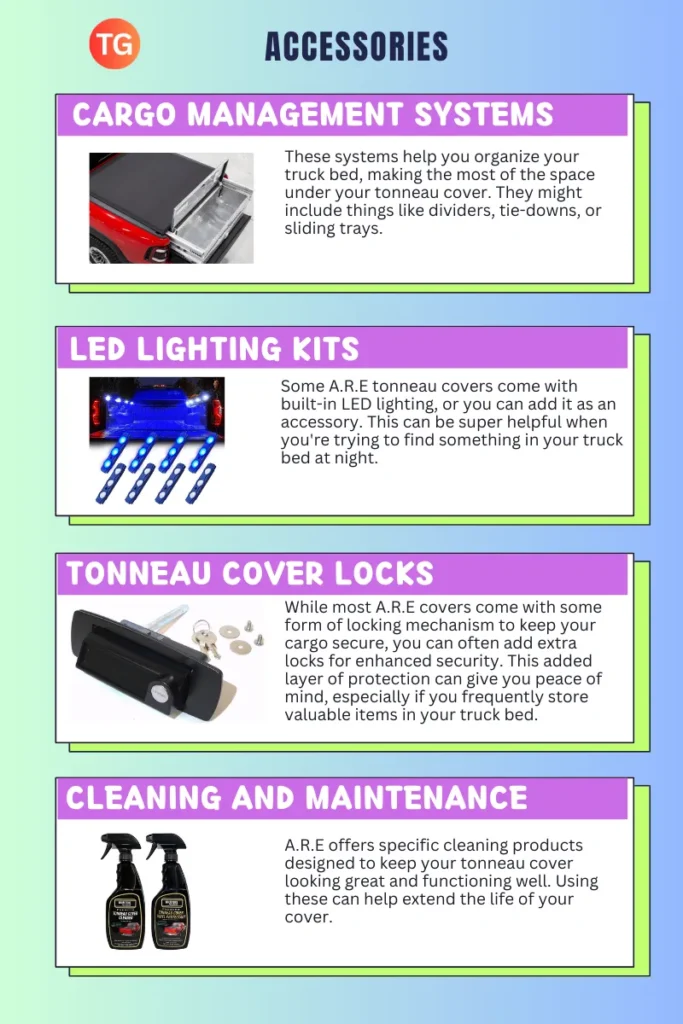
A.R.E offers a range of accessories to enhance your tonneau cover experience:
Cargo Management Systems
These systems help you organize your truck bed, making the most of the space under your tonneau cover. They might include things like dividers, tie-downs, or sliding trays.
LED Lighting Kits
Some A.R.E tonneau covers come with built-in LED lighting, or you can add it as an accessory. This can be super helpful when you’re trying to find something in your truck bed at night.
Tonneau Cover Locks
While most A.R.E covers come with some form of locking mechanism, you can often add additional locks for extra security.
Cleaning and Maintenance Products
A.R.E offers specific cleaning products designed to keep your tonneau cover looking great and functioning well. Using these can help extend the life of your cover.
Final Thoughts
Whew! We’ve covered a lot of ground, haven’t we? From the frame to the cover material, from weather protection to hardware and accessories.
Now you know all about the parts that make up your A.R.E tonneau cover.
Remember, understanding these parts isn’t just about satisfying your curiosity (although that’s a good reason too!). Knowing your tonneau cover inside and out can help you:
- Properly maintain your cover, extending its lifespan
- Quickly identify any issues that need attention
- Make informed decisions if you need to replace any parts
Whether you’re a DIY enthusiast or you prefer to leave maintenance to the professionals, this knowledge will serve you well.
And the next time you’re showing off your truck to your buddies, you can impress them with your in-depth knowledge of tonneau cover parts!

I’ve got a 2007 Chevrolet 1500 with the ARE fiberglass cover i’m wanting to know if y’all sell the replacement handle for the locking mechanism because mine has finally cracked and broke.